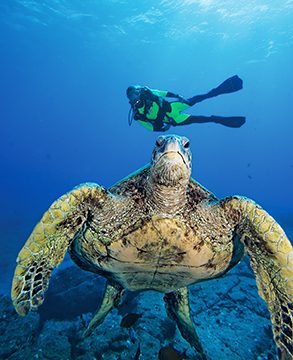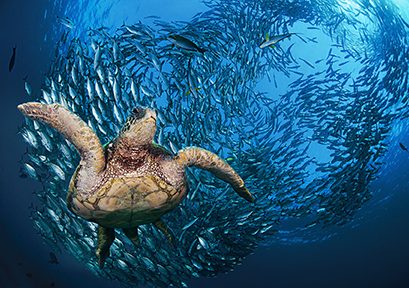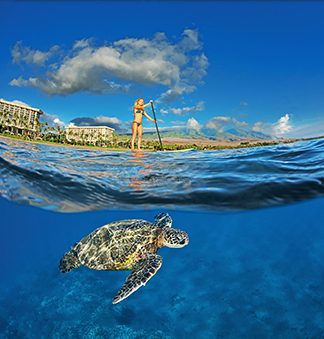Kiat untuk memotret penyu laut
NENEK MOYANG PENYU MODERN shared the oceans with ichthyosaurs and plesiosaurs during the late Jurassic period 150 million years ago. Their descendants now inhabit reefs and oceans around the world. All seven species of sea turtles — the flatback, green, hawksbill, leatherback, loggerhead, Kemp’s ridley, and olive ridley sea turtles — are listed as endangered or threatened under the Endangered Species Act.
Like their land-based relatives, they evolved to have their bony outer shells. The top is known as the carapace, and the underside, which is generally lighter in color, is the plastron. Scutes — large, scalelike plates made of keratin, the same substance as human fingernails and horse hooves — cover both bone layers. The leatherback is the only exception, having a leathery skin over its more flexible carapace.
Depending on where you dive, one species will be more common than others. In my backyard in Hawai‘i you can encounter 100 to 200 green sea turtles for every hawksbill turtle. In the Philippines you typically have an even chance of seeing one or the other. People in some areas of Indonesia still eat sea turtles despite their endangered status and prohibitions against consuming them. Recognizing you as a predator, your photographic subject can make it challenging to get close enough to capture an image of a turtle in these areas. Around the island of Sipadan in Malaysia, however, sea turtles come to mate and have enjoyed protected status for many years. Scuba divers also converge here, and the turtles are used to their presence.
A diver swims near a green sea turtle (Chelonia mydas) in Kauai, Hawai‘i. DAVID FLEETHAM


Other good locations to photograph turtles include Costa Rica, the Bahamas, Florida, Australia, Mexico, and Egypt. Whether you’re staying at a resort or on a liveaboard, ask your guides for dive sites with frequent turtle encounters. Protection laws vary from country to country, so be sure to inquire at your destination for specific rules. Regardless, be respectful of these wild animals, and avoid any interactions that cause stress. Even when photography is your purpose, take a moment to take away your mask from your camera to observe and appreciate these magnificent creatures.
Seekor penyu hijau meluncur di bawah sekumpulan ikan dongkrak di lepas pantai Bali, Indonesia. DAVID FLEETHAM
Sea turtles of all species are independent characters with individual peculiarities you will need to determine to make the most of a photographic opportunity. If a turtle 50 feet away lifts off the reef and swims away from you, take a deep breath, exhale, and look for another subject. This one is not your turtle, and even if you try, you won’t catch a turtle that does not want to be caught. Although relatively slow for sea creatures, most turtles can swim faster and further than humans.
If a turtle does not swim away, approach it slowly, and stop about 10 feet away. If at any point it begins to rise with a push from its front fins, stop and wait for it to settle back down. Even though you’ll be too far away for your strobes to have any effect, take a shot or two, and look for a reaction. If it doesn’t react, this is your turtle. Inch your way closer, frequently stopping to hit the shutter and check on your subject.
This green sea turtle glides below surf instructor Tara Angioletti on a stand-up paddleboard off Canoe Bearch, Maui. Hawai‘i.
DAVID FLEETHAM


Beberapa penyu akan penasaran sampai-sampai meletakkan hidungnya pada port kubah Anda untuk melihat pantulan aneh dan terdistorsi yang menatap ke arah mereka. Ledakan cahaya yang berulang-ulang dari lampu kilat Anda pada akhirnya akan mempengaruhi penyu yang sedang berusaha untuk beristirahat, jadi bersikaplah baik dengan membatasi jumlah foto yang Anda ambil dan menarik pelatuk hanya ketika Anda memiliki sudut yang Anda inginkan.
All turtles will eventually swim toward the surface for a breath of air or along the reef. The time between breaths varies with their activity. They will surface every few minutes when feeding but can stay up to two hours underwater while resting. If they swim up, don’t block their passage. If they have put up with you so far, you can likely swim beside them and snap pictures as you go. Time the tempo of their front flippers to get the appropriate angle. If your subject is willing, keep pushing your shutter release. It is surprising how different turtles can look depending on the position of their fins and the angle of the image. Generally, looking back from slightly ahead of your subject is the most desirable angle.
Seekor penyu hijau muncul ke permukaan untuk menghirup udara di lepas pantai Maui. DAVID FLEETHAM

Jika penyu muncul ke permukaan, tunggu di bawah dan perhatikan mereka. Penyu sangat sadar akan kerentanan mereka terhadap pemangsaan saat berada di permukaan, dan hanya sedikit individu yang mau berhadapan dengan fotografer. Di sela-sela napas, penyu akan memasukkan kepalanya kembali ke dalam air dan melihat ke bawah untuk memeriksa sekelilingnya apakah ada bahaya. Penyu sangat mengenal terumbu karang tempat mereka tinggal dan akan sering kembali ke tempat pertama kali Anda melihatnya, jadi tunggulah di sana.
An upward angle of a swimming turtle will allow you to get a bluewater background, but be careful with your strobe’s power setting. A turtle’s underside can be very reflective. When you are below a turtle, consider turning off your strobes and shooting a silhouette. Increase your shutter speed, and maneuver yourself so the turtle is eclipsing the sun. The faster shutter speed can produce wonderful beams of light, and you can push the shutter over and over or even switch to a drive setting since you don’t have to wait for the strobe to recycle. It is surprising how much light can change in a split second.
Jika penyu Anda sedang melaju di sepanjang terumbu karang, cobalah memotret cangkang atasnya dari atas. Sudut ke bawah umumnya tidak disukai di kalangan fotografi bawah air, tetapi dengan pukulan strobo yang tepat, Anda bisa mendapatkan foto yang tak terlupakan. Kerang dapat bervariasi, tergantung pada seberapa bersihnya, dan yang bersih akan terlihat spektakuler.
Seekor betina akan melakukan perjalanan ratusan bahkan ribuan mil ke pantai tempat ia dilahirkan, dan pejantan akan mengikuti betina untuk kawin sebelum induknya menyimpan telur ke dalam lubang yang digalinya di pasir. Selama perjalanan di lautan terbuka ini, penyu dapat memakan ganggang dan bahkan teritip. Anda dapat melihat penyu menggosokkan plastron mereka pada karang, puing-puing, atau dasar pasir untuk menggosoknya hingga bersih.
Untuk mendapatkan cangkang yang tidak bercacat, penyu mengunjungi tempat pembersihan di terumbu karang, di mana surgeonfish, wrasses, dan butterflyfish akan menggigit pertumbuhan yang menumpuk. Tempat pembersihan ini dapat menawarkan peluang fotografi yang luar biasa. Terkadang Anda dapat menemukan lusinan penyu yang bersedia menjadi objek foto para fotografer. Namun, kawanan ikan yang sedang membersihkan penyu kurang ramah. Sekali lagi, kesabaran adalah kuncinya. Cari jarak di mana para pembersih tidak meninggalkan tugas mereka.
Sering kali, suara hembusan napaslah yang menyebabkan gangguan, jadi, jika Anda akan mencoba untuk lebih dekat, Anda mungkin ingin menahan napas sebentar (pastikan Anda tidak naik ketika melakukannya). Mendekatlah, ambil bidikan Anda, kemudian mundur ke jarak yang aman sebelum Anda bernapas. Tunggu di sana sementara Anda mengatur napas, lalu ulangi. Alat bantu pernapasan sangat ideal untuk situasi ini.
Ketika kelompok penyu berkumpul, sering kali ada satu atau dua penyu yang membuat onar. Saya pernah melihat mereka muncul ke permukaan untuk mengambil nafas dan kembali ke lokasi yang mereka tinggalkan, hanya untuk menemukan penyu lain yang telah menempati tempat tersebut. Beberapa penyu akan menerima hal ini dengan tenang dan mencari tempat lain, tetapi yang lain akan menunjukkan ketidaksenangan mereka dengan mendarat di penyusup dan bahkan menggigit siripnya untuk merebut kembali posisi yang mereka idamkan di terumbu. Ketika konflik terjadi, penyu akan sering mengabaikan fotografer.
Penyu sering kali sangat fokus pada tugas memberi makan sehingga Anda bisa bertemu lebih dekat. Waspadai sikap mereka saat Anda mendekat, dan luangkan waktu Anda sehingga mereka dapat mempercayai niat Anda. Penyu sisik yang sedang memberi makan adalah subjek yang sangat bagus untuk diambil gambarnya, terlebih lagi untuk video. Mereka akan sering memindahkan batu dan karang untuk mendapatkan spons yang tepat, sehingga Anda dapat melihat mereka mengunyah makanan dengan menggunakan leher yang sangat panjang dan paruh yang mirip burung. Penyu hijau, di sisi lain, memiliki mulut yang tidak terlalu menonjol dengan rahang bergerigi untuk makanan herbivora mereka.
There is no wrong lens for photographing sea turtles, but a wide-angle zoom lens is most photographers’ go-to choice. In many locations it is happenstance to encounter a turtle, so you can make it work with whatever lens you have. I have shot turtle face portraits with a 100mm macro lens and used a full-frame fisheye lens to capture reef scenes that include a turtle. A fisheye lens tends to distort the turtle the closer you get, so pay attention to your composition when using one.
Sea turtles are beautiful subjects. They continue to navigate an environment that’s increasingly threatened by changes to our planet. Risks to their populations include loss of habitat, fishery bycatch, plastic waste, and illegal trade in their eggs, meat, and shells. Treat them respectfully, and they will deliver exceptional images to delight you and your audience.
Dengan foto-foto Anda, Anda dapat membagikan kisah para pelaut kuno yang menarik ini dan perjalanan mereka untuk bertahan hidup. MASEHI
© Penyelam Siaga — Q4 2022